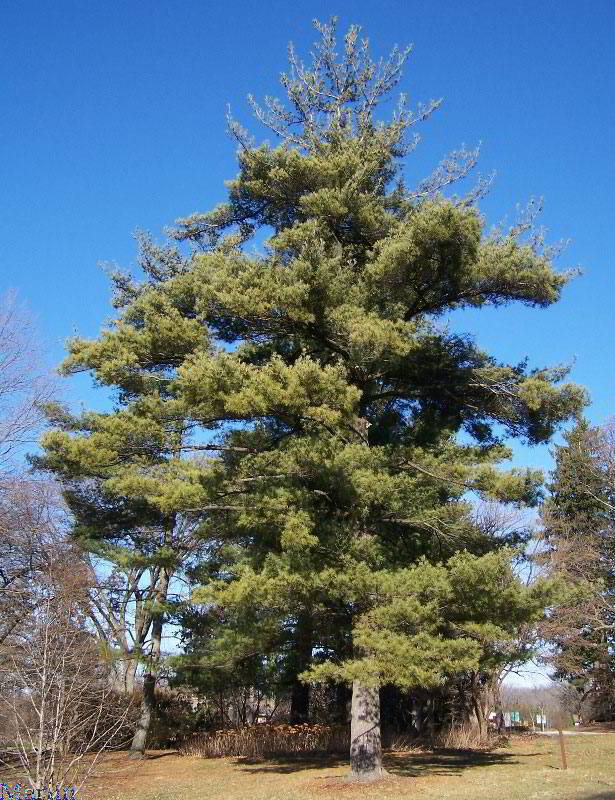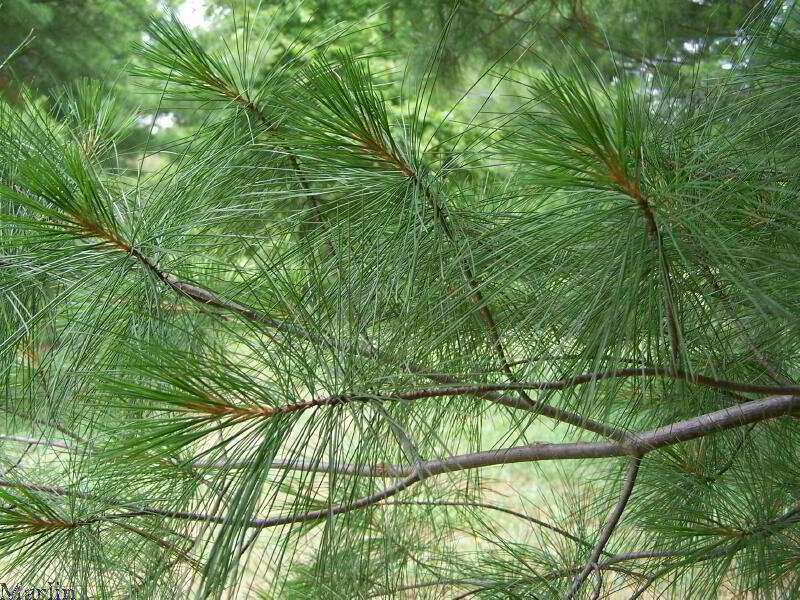Eastern White Pine Tree – Pinus strobus

The age of this Morton Arboretum Specimen is unknown.
Family Pinaceae: Pine, Cedar, Spruce, Fir. The only five-needle pine native to eastern North America, it is the largest of the eastern conifers.
White Pine bark darkens and thickens as the tree ages, is smooth and gray on young growth. It becomes gray-brown, deeply furrowed with broad ridges of irregularly rectangular, purple-tinged scaly plates. Branches are whorled, few and spreading, with slightly upturned tips. In closed stands, trunks are free of branches over 2/3 of their length. Twigs are slender, flexible, pale red-brown, with rusty hairs when young; aging gray and smooth.
White pines commonly live to 400 years. Height: to 110′ / Spread: 40′

Needles soft, flexible, blue-green; 2″-4″ long, 3-sided, in bundles of five. Evergreen. Buds are heavily resinous and sticky, aromatic. Cones are slender and thornless, 3″-10″ long and tapering; each scale usually bears two winged seeds as do all native pines. Roots are widespreading and moderately deep, without a distinct taproot.
Disease: White Pine Blister Rust (Cronartium ribicola), an introduced fungal disease, has decimated formerly extensive stands. Occurs on a variety of sites from wet bogs and moist streambottoms to dry sand plains and rocky ridges; common on the east shore of lakes where blowdowns create openings for regeneration. Soils: grows on nearly all soil types within its range. Most competitive on fairly infertile sandy soils. On clay or poorly drained soils, occurs only as individuals or in small groups. Grows on fine sandy loams and silty loams on disturbed sites with little hardwood competition.

Range: Northern North America, south in mountains
Wildlife: Squirrels, chipmunks and mice feed on the seeds and soft needles. Inner bark is a preferred winter food of porcupine and deer browse the twigs. Rabbits may eat the bark of young trees. The seeds are eaten by red squirrels and such birds as crossbills and pine siskins. Pocket gophers graze the roots of seedlings and young trees. Snowshoe hares, white-tailed deer, and cottontails browse the foliage; the bark is eaten by various mammals. Young black bear cubs use large White Pine to climb to safety. Songbirds eat seeds. Bald eagles build nests in living White Pine, usually at a main branch located below the crown top.
Fire, windstorm damage and lightning strikes often cause wounds or kill trees, opening the way for attack by the whitespotted sawyer beetles (below) or other insect pests that are attracted by chemicals emitted by the tree when undergoing severe stress, injury or death. The beetles lay eggs in bark crevices and the larvae mine the cambium layer and pupate in the heartwood. Adult sawyers feed on the tender bark of new shoots, causing the tips to turn brown and die.
Whitespotted Sawyer Beetle – Monochamus scutellatus
Nearly an inch long with antennae 1.5 times that, this impressive beetle is a pest of coniferous forests across North America. Hosts most often include balsam fir, spruce and especially white pine. Adult female beetles are attracted to chemicals released by injured, dying, or recently killed trees, where they lay their eggs in crevices in the bark or open wounds.
When the eggs hatch, the resultant larvae bore a tunnel through the phloem into the vascular cambium (the still-developing inner bark of the tree that will eventually conduct nutrients and liquids from the roots to the foliage), where they mine beneath the bark and mature through several instars, eventually pupating in a gallery near the surface. Adults exit these galleries in late spring (this specimen was photographed on May 22nd) and early summer, and begin feeding on the tender bark of new twigs, causing the tips to die and turn brownish-red [2].
References:
1. United States Forest Service Silvics Manual Conifers / Pinus strobus
2. USDA Forest Service, Buggwood Network, “Whitespotted Sawyer Monochamus scutellatus”
3. USDA NRCS Threatened and Endangered species
4. USDA, ARS, National Genetic Resources Program. Germplasm Resources Information Network
5. University of Michigan Native American Ethnobotany
6. Uchytil, Ronald J. 1991. Pinus strobus, Fire Effects Information System, U.S. Department of Agriculture
Tree Encyclopedia | Tree Index
Trees live longer than any other organism on earth. Trees commonly live more than 1,000 years, and many grow considerably older. Trees have been living on Earth for more than 370 million years, and today can be found almost everywhere from the Arctic Circle to the Sahara Desert. Explore over 2,000 large format pictures of trees in more than 400 species. Family Pinaceae: Pine, Cedar, Spruce, and Fir
